|
Hello!
WELCOME TO DAYLILY E-NEWS, a free electronic newsletter brought to you by the American Hemerocallis Society, also known as AHS. Daylily E-News is for all who share an interest in daylilies, including members of the American Hemerocallis Society and other horticultural organizations, educators, garden writers, news media, and anyone who loves to garden. In this issue, Dan Trimmer of Water Mill Gardens in Enterprise, Florida tells us all about the care and feeding of daylilies to make them look their best.
Beverly Parker, featured photographer for this issue, gardens in Fort Worth, Texas. She retired in 2001 and found herself with lots of time on her hands. Since she was bored and loved to garden, she went shopping and liked to wander through the plant nurseries. She came upon some cute little yellow flowers that turned out to be H. 'Stella de Oro'. She bought about four pots of them and planted them in front of her irises. The next year they bloomed and she really liked them, and her love of daylilies grew from that point.
It's show time for many areas of the country! Look for a daylily show in your area on the AHS website: 2014 Exhibitions.
If you are thinking of exhibiting in a show this year, there are two excellent PowerPoint presentations available on the AHS Membership Portal: "Preparing to Exhibit Daylilies" and "Exhibition Shows for Enthusiasts." Just click on the tab for the AHS Media Library and download them for free!
Be sure to click on the Facebook "like" button and share this issue with your friends!
If you are not yet a Daylily E-News subscriber, sign up via the link at the AHS website: Daylily E-News.
You may unsubscribe from Daylily E-News at any time by clicking on SafeUnsubscribe, which you will find in each issue.
We hope you enjoy
Daylily E-News!

Elizabeth Trotter
E-News Editor
|
|
Thank you to our advertisers for sponsoring this issue of Daylily E-News!
|
|

CONTEST TIME

PHOTO CONTEST

Shoot daylily and garden photos this summer and submit them by November 1. Details at Youth Photo Contest.
CONGRATULATIONS
Region 11 youth members, Michael Kowalchyk and Thomas Loewen, won double daylilies donated by Nancy Eller of Georgia in the Double Deal contest.
IT'S SHOW TIME
Consider exhibiting your daylilies at a show this season. First time exhibitors may find some pointers at Entering a Daylily Show.
|
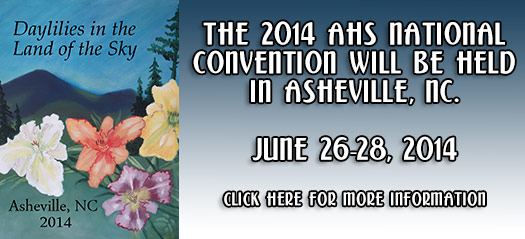 |
|
THE CARE AND FEEDING OF DAYLILIES
 by Dan Trimmer by Dan Trimmer
By formal education I should be qualified to discuss international politics, but have zero qualifications to talk about any horticultural endeavors. However, I have no experience in the political world, and I have about 25 years' experience growing daylilies; in excess of 15 years as a commercial enterprise. I've learned my daylily lessons via the school of making more mistakes than I'd like to admit, and by asking as many people as possible to share what they knew, oftentimes via their formal education. So here is a very quick overview of the lessons I have learned.
Number one is: WATER, WATER, WATER. If you do nothing else to your flower beds, which hopefully are filled with daylilies, provide at least 1 to 1-1/2 inches of water per week. This is more important than any feeding program.
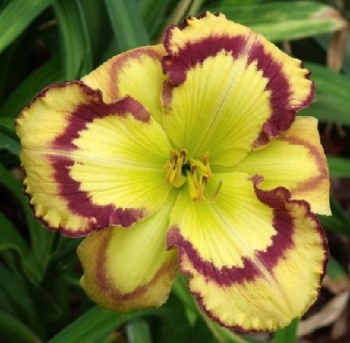 | | H. 'Starburst Fantasy' (Trimmer, 2012) |
Number two on the list of "things to do" is to take pH readings in each of the locations where you grow daylilies. Regardless of how much nutrition is present, not much is going to be available to your plants unless your pH is in the 6.2 to 6.8 range. I've found inexpensive pH meters to be rather accurate when I compare them to lab tests of the same beds I've just tested with my "el cheapo" meter. In addition to the accurate pH test the laboratory will provide for you, it's important to get a baseline of what nutrition and element levels are present in your beds. You can't know what to add unless you know what you need. In the United States, your local County Cooperative Services may be able to provide this service to you at a very reasonable cost. Amend as necessary to correct any pH problems.
Whenever possible, incorporate as much organic material as you can get your hands on into your garden beds. Compost, composted leaves, animal manures, cottonseed meal, corn meal, bone meal, and the like will help keep your soil loose, provide valuable trace minerals, and retain moisture. This topic could be an entire article, but I'll stop here.
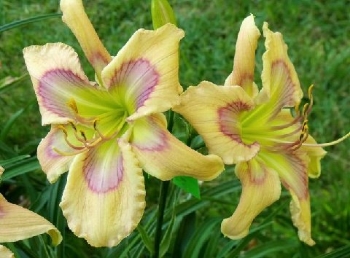 | | H. 'Dragonfly Dawn' (Trimmer-J., 2010) |
THE BIG THREE: The nitrogen, phosphorus, and potash (potassium) that we see listed on the front of our fertilizer bags deserves quite a bit of discussion. We must understand that our daylilies are not typical perennials. With most of our flowering plants a "balanced" diet is recommended lest we get too much leaf and little bloom. Thus 10-10-10 or 6-6-6 fertilizing programs are recommended. This is not the case with daylilies. Daylilies are monocots. Daylilies prefer to feed at a ratio of 3-1-2, or when in active growth 4-1-2. Thus, 18-6-12 should be an ideal mix for daylily growers. Compounding the typical lack of nitrogen problem, my laboratory tests always seem to reveal the fact that the middle number in fertilizer (phosphorus) is not easily soluble, while most of the nitrogen is quickly leached away. The bottom line is that if we do feed our plants year after year in the same beds, we may end up with much too much phosphorus, to the point where it is toxic. Before this happens, and if your soil tests come back showing that you have adequate levels of phosphorus, try feeding with small amounts of calcium nitrate (which will also help raise a low pH) or ammonium sulfate (which will help lower pH) and potassium nitrate throughout the season. This will provide the nitrogen our plants like along with other valuable elements. If you make a mistake, let it be putting out too little - not too much - of these products. They can be very powerful and can cause severe burning.
 | | H. 'Waves of Joy' (Trimmer, 2012) |
Early in the growing season, in addition to the basic fertilizer regime, it's important to add what I'll call the "major minors": iron (a minor element), magnesium, and calcium (both secondary major elements). Iron can come from a source such as Milorganite or an iron supplement. I get much of my magnesium from Epsom salts (which is magnesium sulfate) and apply at a rate of 100 pounds per acre, and additional calcium from the earlier-mentioned calcium nitrate. Several professional horticulturalists have told me it's important to get these "major minors" out early in the growing season, when needed, as they are required in order for the plants to be able to take up the Big Three (nitrogen, phosphorus, and potash). When I lived on Long Island, this active growth period started just after the dormant daylilies broke dormancy. The second very serious feeding period was after bloom season with the first cool weather in the early fall. It's important not to use a time-release fertilizer at this time, as we want our rapid growth to end before the onset of very cold weather. This second feeding period can result in twice the plant growth the following year as compared to unfed plants. In Florida or the Deep South, we can't feed too much in the summer due to the excessive heat, so most of the feeding takes place from November through March.
I've found that the frequent feeding of liquid plant food in modest amounts works wonders. It's also important to vary the product applied. A Peter's Excel product known as Cal Mag 15-5-15 seems to make my plants very happy. (A lab test will also tell you if the appropriate amounts and balance of calcium and magnesium are present.) I liquid feed any number of other products, most with a very high first number (nitrogen).
A last couple of thoughts. Firstly, risk using too little fertilizer - not too much. I can't say this in too loud a voice! Secondly, organic sources are better than chemical fertilizers; but for large gardens, we have little choice but to use the above-mentioned chemical fertilizers.
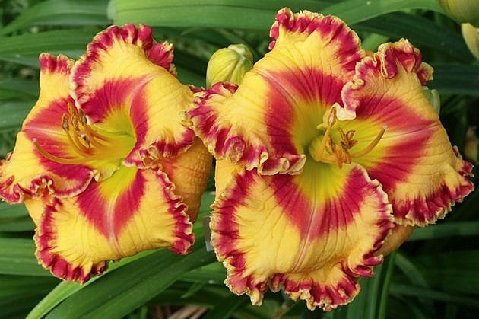 | | H. 'Parrots of the Caribbean' (Trimmer, 2009) |
Happy Gardening!
|
|
| The American Hemerocallis Society, Inc., is a non-profit corporation organized exclusively for educational and scientific purposes, and especially to promote, encourage, and foster the development and improvement of the genus Hemerocallis and public interest therein. |
| AHS Daylily E-News Committee: Elizabeth Trotter (KY), Editor, E-News; Sue Bergeron (ON, Canada); Ken Cobb (NC); Julie Covington (VA); David Kirchhoff (KY); Nikki Schmith (IL); John Ware (VA). |
| Daylily E-News © 2014 by the American Hemerocallis Society, Inc. |
|
|
|
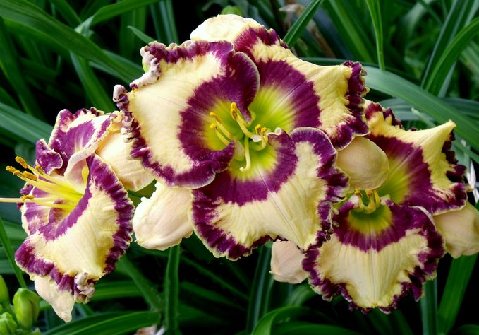
Hemerocallis 'Ima Masterpiece' (DeVito, 2012). Click photo for larger image.
| | Locate an AHS group near you! | |
The American Hemerocallis Society is all about daylilies and people.
AHS is organized into 15 Regions including USA, Canada, and International designations. Each offers a variety of regional and local club daylily activities.
When people join AHS, they also become a member of the AHS Region in which they live. AHS Regions do not charge additional dues. Most AHS regions publish their own newsletter and mail it to all regional members at no extra charge. Members often participate in events outside their own region.
To learn about daylily activities and events near you, visit the webpage:
AHS Regional Activities
|
|

|
| |
|
Hemerocallis 'The New Normal'
(Douglas-H., 2014). Click photo for larger image.
| |
Why Join AHS?
| |
Learn about daylilies.
Receive the quarterly publication, The Daylily Journal.
Receive a regional newsletter 2-3 times per year.
Enjoy a members-only social networking site with forums, blogs, calendars, and more.
Meet daylily growers and hybridizers.
Vote for favorite daylilies in the Popularity Poll.
Participate in daylily exhibitions.
Become an AHS Exhibition Judge.
Become an AHS Garden Judge.
Have an AHS Daylily Display Garden and/or AHS Historic Daylily Display Garden.
Attend daylily symposiums, garden tours, meetings, conventions, and more.
Participate in on-line discussion groups.
Join special interest snail-mail groups.
Become a better gardener.
Form friendships for life!
AHS members belong to one of 15 U.S./Canadian regions. Those outside the U.S. and Canada may join as International members. Over 180 local clubs form the backbone of every region, and you may find that one of them is near you. If not, meet with local gardeners and form a daylily club of your own!
It's easy to become a member. Just use this link: Join AHS
|
|

Hemerocallis 'Voila Francois' (Stamile, 2008). Click photo for larger image.
| |
What is the AHS Membership Portal?
|
The AHS Membership Portal is a feature-rich website operated by AHS for the benefit of its members.
In 2013, the Portal was completely redesigned for easier navigation and user convenience. A new tour of the Portal's features and benefits has been created by Portal Help Desk member Michael Bouman, with recorded narration for every slide. A video of the tour is available for people who don't have PowerPoint on their computer. Both the PowerPoint download and the streaming video are posted on the Portal's Help Page. (The "Help" button is located on the right side of the listing of drop-down buttons near the top of the page.) The Portal home page is located at www.daylilynetwork.org.
We hope members will take a look around the site to see the changes that have been made. If you are having a problem accessing any of the features, hit the "Contact Us" button at the very top row of buttons on the right of the page or click on the "Contact" button just to the left of "Help" in the row of buttons near the top.
If you are not a member of the AHS and are interested in joining, you can do it right from the home page noted above.
Want to learn more about the benefits of joining the AHS? Click on the "Membership" button near the top, pick "Join/Renew" from the drop-down menu, and then pick "Membership Benefits."
We hope you enjoy the new look of the site!
Mary Collier Fisher,
There is something for everyone on the AHS Membership Portal.
Discover it today!
Visit:
|
| |
Would you like to reach over 3,900 garden and daylily enthusiasts?
Advertise in the
Daylily E-News!
To learn more about advertising in the Daylily E-News, click
| |
|
Hemerocallis 'Volaris' (Pierce-G., 2012). Click photo for larger image.
| |
|
SPELLING LESSON
| |
How to spell
"daylily"
| |
The word "daylily" is properly spelled as one word. Many of today's spellcheckers and media style books incorrectly use the old-fashioned spelling "day lily" instead. The single word has been the preferred spelling for decades.
|
|
|
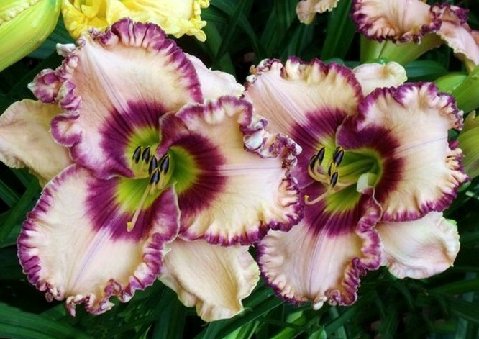
Hemerocallis 'Sunday River' (Reilly, 2009). Click photo for larger image.
| |
What is a Daylily?
| A daylily is an herbaceous perennial that will return year after year in a suitable climate. Some are evergreen and will retain their green foliage throughout the year in a mild climate.
Daylilies may be hardy or tender, depending on genetics, so gardeners should choose cultivars based on their local growing conditions
Daylilies belong to the genus Hemerocallis, from the Greek meaning "beauty for a day." A typical daylily bloom lasts for one day, but an established clump will produce many flowering scapes with plentiful buds that will produce a fresh flush of blooms over many days.
Daylilies do not form bulbs (as do members of the genus Lilium, otherwise known as "true" lilies).
Due to the distinctive characteristics of Hemerocallis, taxonomists have removed daylilies from the family Liliaceae and placed them in their own family Hemerocallidaceae.
Daylilies form a crown, with fibrous roots below and foliage and flowering scapes above. The daylily crown is the essential growth center of the plant. Neither true daylily root structures nor daylily foliage will grow without a piece of the crown.
Some daylilies form rhizomes - special underground structures with scales and internodes - that can produce new plants. The species or "wild" types often have this trait. Many modern hybrids do not form rhizomes, although there are some that do.
|
|

Hemerocallis 'Geneva After Burner' (Hansen-D., 2012). Click photo for larger image.
For previous issues of DAYLILY E-NEWS visit the archives:
| |
|
|